Attractions in Istanbul
Historical and Cultural Highlights
Historical Attractions in Istanbul, Turkiye
Istanbul, a city that straddles two continents, has long been at the crossroads of civilizations. Its rich history is a tapestry woven from the legacies of the Byzantine, Roman, and Ottoman empires, making it a melting pot of cultures, architecture, and traditions. As you explore Istanbul, you’ll find yourself walking through layers of history, each era leaving its indelible mark on the city’s fabric. This guide introduces you to the key historical sites that are emblematic of Istanbul’s past and treasures of global significance.
Key Historical Sites
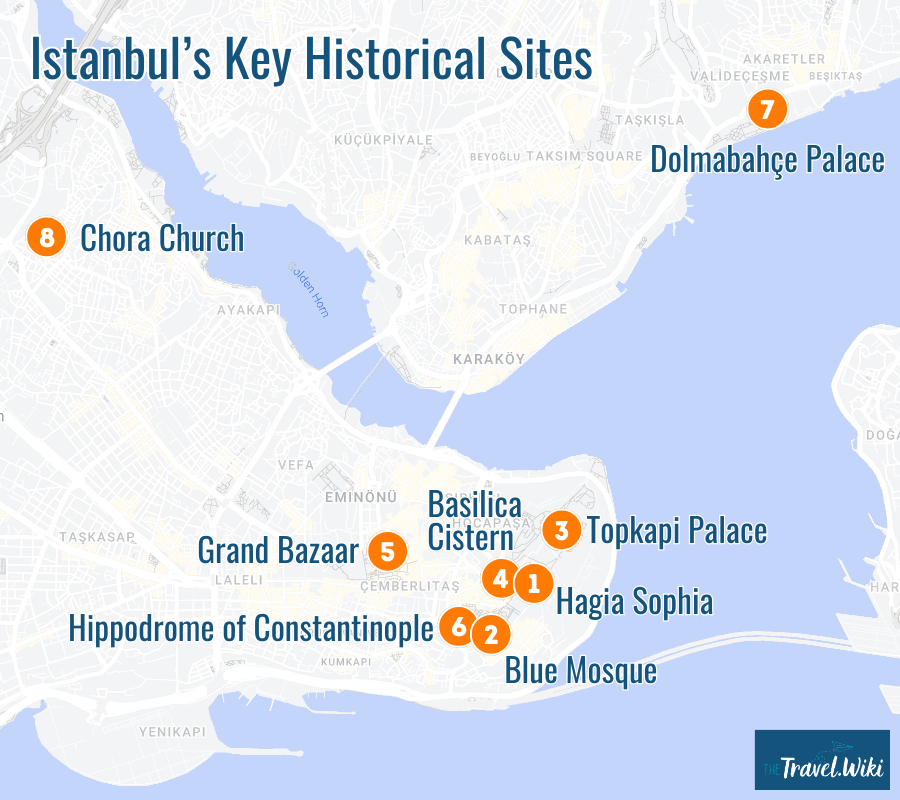
Istanbul, a city where history and culture intertwine seamlessly, is home to some of the most breathtaking and historically significant sites in the world. Let’s take a look at the key historical landmarks that define the city’s rich heritage. Discover detailed histories, architectural marvels, cultural significance, and practical visiting tips for each location to enhance your journey through this timeless city.
Hagia Sophia (Ayasofya)
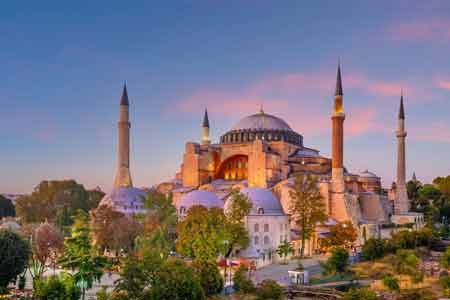
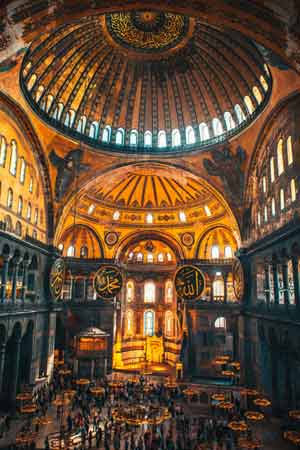
Hagia Sophia, originally built as a cathedral in 537 AD during the Byzantine Empire under Emperor Justinian I, stands as a testament to architectural grandeur and religious significance. For nearly a millennium, it was the world’s largest cathedral and an engineering marvel of its time. After the Ottoman conquest of Constantinople in 1453, it was converted into a mosque, and in the 20th century, it was secularised and turned into a museum. It has recently been reconverted into a mosque, yet it remains a universal symbol of Christian and Islamic heritage.
Architectural Highlights
The Hagia Sophia is renowned for its massive dome, considered a breakthrough in architectural design and a precursor to the Renaissance. The interior is adorned with stunning mosaics, marble pillars, and impressive calligraphy. Its central dome, supported by pendentives, is an architectural feat, creating a sense of heaven on earth. The synthesis of Ottoman and Byzantine architecture makes it unique, symbolising the confluence of East and West.
Tips for Visiting Hagia Sophia
- Best Times to Visit: Early morning or late afternoon to avoid crowds. Non-prayer times are ideal for visiting.
- Ticket Information: As of my last update, there’s no entrance fee, but this could change, so check the latest information.
- Dress Code: Respectful attire is required, as it functions as a mosque. Women should cover their heads, and both men and women should wear clothing that covers their legs and shoulders.
- Photography: Allowed, but avoid flash and be respectful during prayer times.
- Guided Tours: Consider a guided tour for a more in-depth understanding of its history and architecture.
Hagia Sophia Tickets and Tours
The Blue Mosque (Sultan Ahmed Mosque)
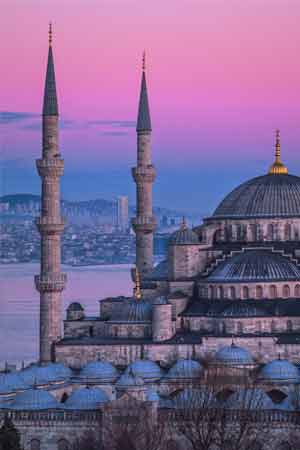
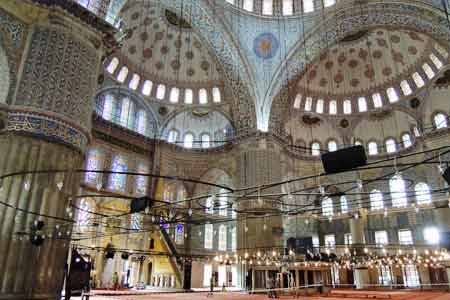
The Sultan Ahmed Mosque, known as the Blue Mosque, is a historic mosque in Istanbul, built between 1609 and 1616 during the rule of Ottoman Sultan Ahmed I. It was constructed to reassert Ottoman power and is considered a response to the grandeur of the Hagia Sophia. The mosque’s design combines traditional Islamic architecture with Byzantine elements, a symbol of the Ottoman Empire’s power and artistic prowess.
Architectural Highlights
The mosque’s most striking feature is its six minarets, a rarity and a symbol of prestige. The interior is adorned with over 20,000 handmade blue Iznik tiles, giving the mosque its famous nickname. The cascade of domes and semi-domes, the grand scale of the prayer hall, and the intricate calligraphy of Quranic verses enhance its spiritual and architectural presence.
Tips for Visiting The Blue Mosque
- Best Times to Visit: Non-prayer times, preferably early morning or late afternoon.
- Ticket Information: There is no entrance fee, but donations are appreciated.
- Dress Code: Modest clothing is required. Women should cover their hair, and both men and women should cover their legs and shoulders.
- Photography: Allowed, but non-intrusive and respectful of worshippers.
- Guided Tours: Recommended for a deeper understanding of its history and architecture.
The Blue Mosque Tours
Topkapi Palace
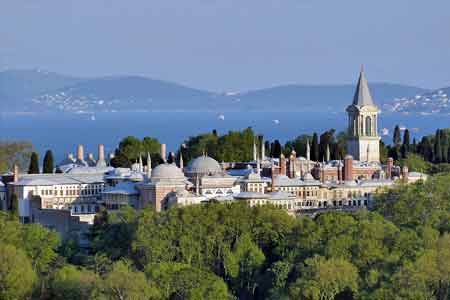
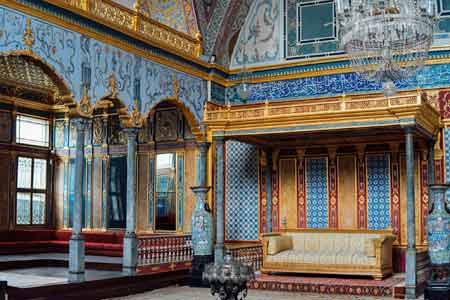
Topkapi Palace was the heart of the Ottoman Empire for nearly 400 years, from its construction in 1459 by Mehmed the Conqueror until the mid-19th century. It served as the royal residence, administrative headquarters, and military stronghold of the Ottoman Sultans. The palace witnessed significant historical events and decisions that shaped the empire and its territories.
Architectural Highlights
The palace is a complex of various buildings and courtyards, each with its unique purpose and design. Notable areas include the Imperial Council Chamber, the Harem, the Treasury holding the Topkapi Dagger, and the Imperial Hall. The architecture reflects Islamic and Byzantine styles, with rich decorations, ornate tilework, and lush gardens.
Tips for Visiting Topkapi Palace
- Best Times to Visit: Mornings or late afternoons to avoid crowds.
- Ticket Information: Separate tickets for entry and for visiting the Harem.
- Guided Tours: Available and recommended for a comprehensive experience.
- Photography: Allowed in most areas but restricted in some sections like the Harem.
- Additional Information: Plan to spend several hours exploring the complex fully.
Topkapi Palace Tickets and Tours
The Basilica Cistern (Yerebatan Sarnıcı)
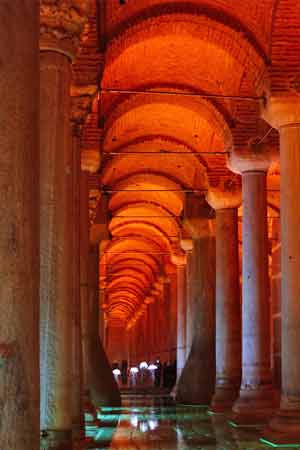
Topkapi Palace was the heart of the Ottoman Empire for nearly 400 years, from its construction in 1459 by Mehmed the Conqueror until the mid-19th century. It served as the royal residence, administrative headquarters, and military stronghold of the Ottoman Sultans. The palace witnessed significant historical events and decisions that shaped the empire and its territories.
Architectural Highlights
The palace is a complex of various buildings and courtyards, each with its unique purpose and design. Notable areas include the Imperial Council Chamber, the Harem, the Treasury holding the Topkapi Dagger, and the Imperial Hall. The architecture reflects Islamic and Byzantine styles, with rich decorations, ornate tilework, and lush gardens.
Tips for Visitors of the Basilica Cistern
- Lighting: The cistern is dimly lit to preserve its atmosphere; bringing a small flashlight can enhance your exploration.
- Walking Paths: Wooden walkways are provided; wear comfortable shoes as the ground can be slippery and uneven.
- Photography: Ideal for photography, but tripods may not be allowed. Low-light settings are recommended.
- Tickets: Entry is ticketed, and it’s advisable to check for updated prices and possible online ticket options to avoid queues.
Basilica Cistern Tickets and Tours
The Grand Bazaar (Kapalıçarşı)
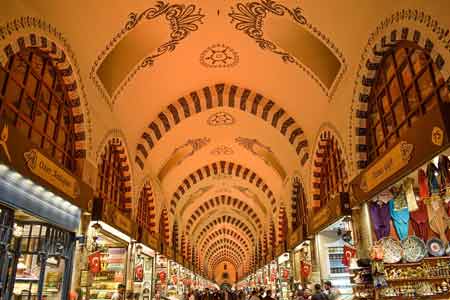
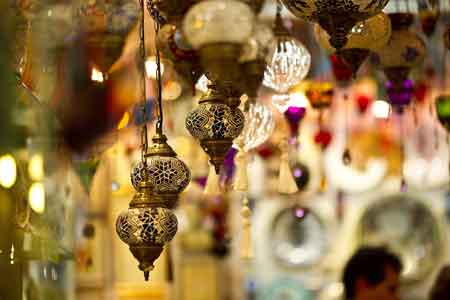
History of Grand Bazaar as a Trading Center
The Grand Bazaar, known as Kapalıçarşı in Turkish, is one of the largest and oldest covered markets in the world. Established in the 15th century, it has been the heart of Istanbul’s trading and commercial life for centuries. With over 4,000 shops spread across 61 streets, it was a trade centre and a social hub in Ottoman times. The bazaar has been an important trading centre for goods like textiles, jewellery, spices, and ceramics, linking trade routes from Europe and Asia. Its vibrant atmosphere and unique setting have made it a popular location for films, including several James Bond movies, showcasing its enduring appeal and cinematic charm.
Guide to Navigating the Bazaar
Navigating the Grand Bazaar can be overwhelming due to its size and maze-like structure. It’s divided into sections based on the type of goods sold, making it easier to locate specific items. Key areas include the gold and silver section, carpet sellers, and the spice area. Maps of the bazaar are available online and at entrances.
Tips on What to Buy and How to Bargain
- What to Buy: Look for authentic Turkish goods like carpets, ceramics, spices, and textiles. Be wary of counterfeit goods.
- Bargaining: Bargaining is part of the shopping experience. Start by offering half the quoted price and negotiate to a middle ground.
- Payment: Many shops accept credit cards, but carrying some cash is advisable for smaller purchases and better bargains.
Grand Bazaar Tours
The Hippodrome of Constantinople
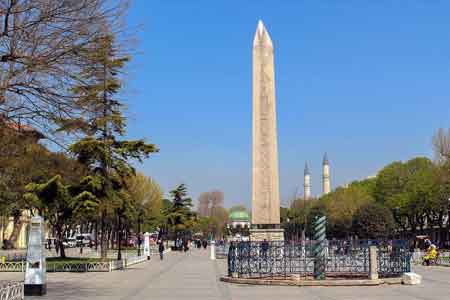
Historical Significance in Byzantine and Ottoman Periods
The Hippodrome of Constantinople, known as Sultanahmet Square, was the epicentre of Byzantine public life and an arena for chariot races, political gatherings, and celebrations. Built by the Roman Emperor Septimius Severus in the 3rd century and expanded by Constantine the Great, it was one of the largest racetracks in the ancient world. During the Ottoman era, the Hippodrome continued to be a focal point for communal gatherings, though its role in sports and entertainment diminished over time.
Description of Remaining Structures
Today, several significant monuments still stand in the Hippodrome area:
The Serpentine Column
Originally from Delphi, this ancient Greek column was brought to Constantinople by Constantine the Great.
The Obelisk of Theodosius
An ancient Egyptian obelisk erected by Theodosius I in the 4th century.
The Walled Obelisk
Constructed of masonry by Constantine VII in the 10th century. These remnants provide a glimpse into the Hippodrome’s grand past and are important symbols of the city’s layered history.
Dolmabahce Palace
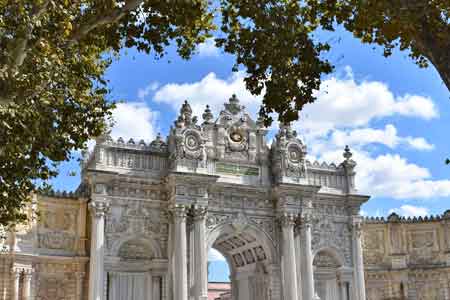
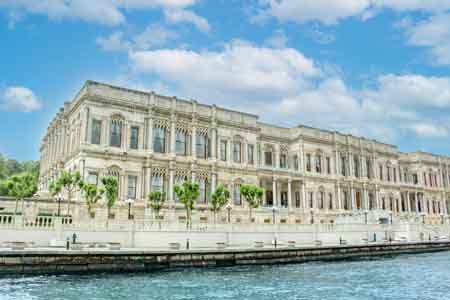
The Palace’s Role in the Late Ottoman Era
Dolmabahçe Palace, constructed in the 19th century, marked a shift in Ottoman architecture towards a more European style. It served as the main administrative centre of the Ottoman Empire from 1856 to 1922, replacing Topkapi Palace. This transition reflected the empire’s modernization efforts and westernizing trends. The palace witnessed significant historical events, including the Ottoman Empire’s last days and the Turkish Republic’s early years.
Highlights of the Palace Tours
Visitors to Dolmabahçe Palace can explore various sections, including:
- The Ceremonial Hall boasts a 4.5-ton chandelier and expansive ceremonial space.
- The Harem: Offering a glimpse into the private life of the Sultan and his family.
- Atatürk’s Room: Where Mustafa Kemal Atatürk, the founder of modern Turkey, spent his last days.
Information on Tickets and Visiting Hours
- Tickets: Separate tickets are required for the main palace and the Harem section.
- Visiting Hours: Check the latest visiting hours, as they vary seasonally. Guided tours are available and are the only way to see the interior.
- Photography: Allowed on the palace grounds but often restricted inside the buildings.
Dolmabahce Palace Tickets and Tours
Chora Church (Kariye Museum)
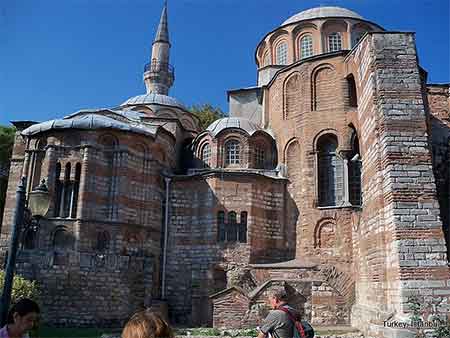
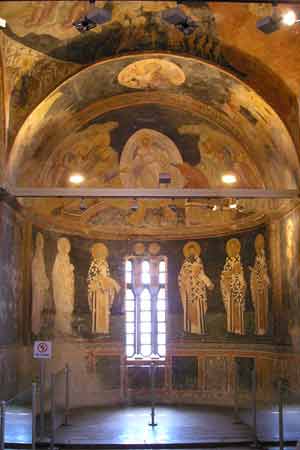
Images © Wikimedia Commons
History and Transformation Over Centuries
The Chora Church, now known as the Kariye Museum, is a historic Byzantine church in the Edirnekapı neighbourhood of Istanbul. Originally built in the 4th century, it underwent several reconstructions, most notably in the 11th and 14th centuries. The church is renowned for its stunning Byzantine art, which survived various transformations throughout its history. After the Ottoman conquest of Constantinople, it was converted into a mosque and then into a museum in the 20th century. Recently, it was reconverted into a mosque, yet it remains a significant monument showcasing Byzantine artistic achievement.
Significance of the Mosaics and Frescoes
The Chora Church is particularly famous for its exquisite mosaics and frescoes, considered some of the finest surviving examples of late Byzantine art. These artworks primarily depict biblical scenes and figures characterized by vivid colours and intricate details. The mosaics and frescoes cover a significant portion of the interior, providing a glimpse into the religious and artistic culture of the Byzantine Empire.
Tips for Visiting Chora Church
- Visiting Hours: Check for current visiting hours, as they may vary and are subject to change due to its status as a functioning mosque.
- Tickets: Entry details should be confirmed closer to your visit, as policies may change.
- Dress Code: As a religious site, appropriate dress is required. Women should cover their heads, and men and women should wear clothing covering their legs and shoulders.
- Photography: Usually permitted, but it’s advisable to check the latest guidelines, especially regarding the use of flash.
Other Notable Historical and Cultural Sites in Istanbul
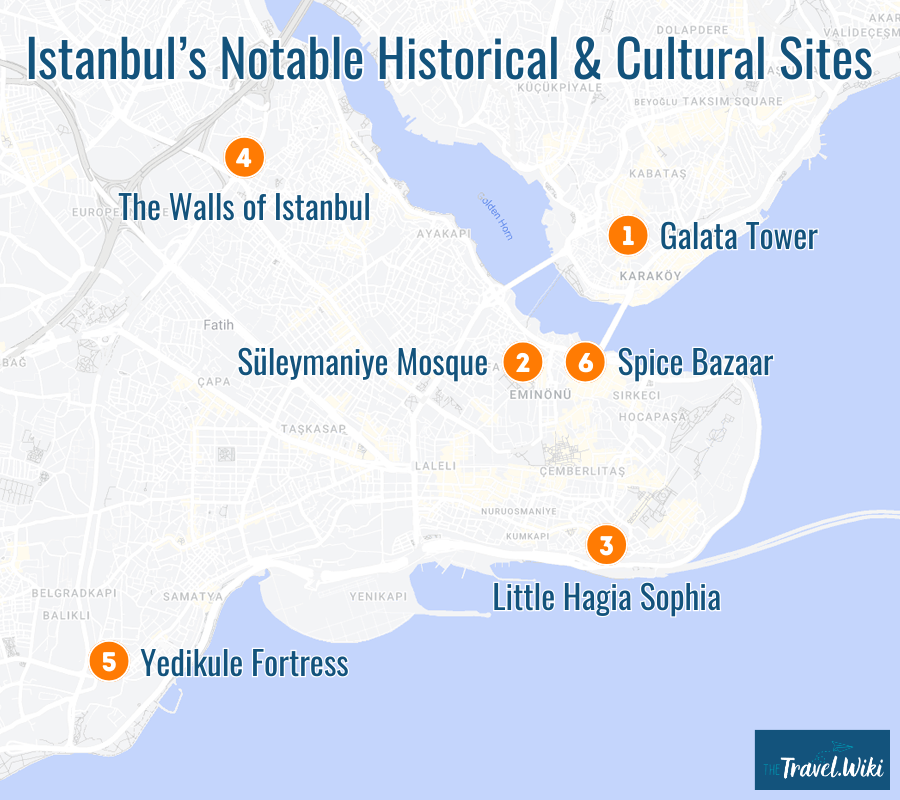
Beyond the renowned landmarks, Istanbul’s historical tapestry includes numerous other noteworthy sites. This guide highlights additional locations that offer rich cultural and historical insights. From medieval towers and majestic mosques to ancient fortifications and bustling bazaars, these sites collectively enhance the understanding of Istanbul’s diverse heritage. Explore these treasures to fully appreciate the depth and breadth of the city’s storied past.
Galata Tower
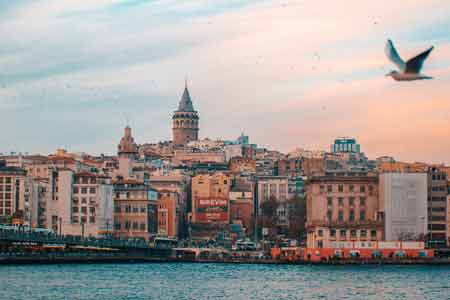
- An iconic medieval stone tower offering panoramic views of the city and the Bosphorus.
- Originally built as a watchtower, it is now a popular tourist attraction.
Galata Tower Tickets and Tours
Suleymaniye Mosque
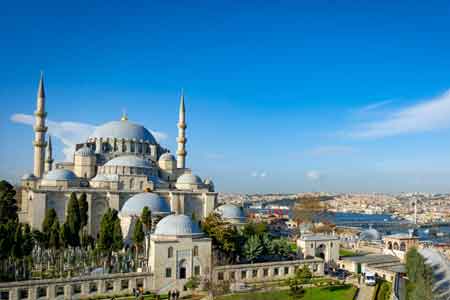
- A magnificent mosque built by the famous Ottoman architect Sinan for Sultan Suleiman the Magnificent.
- Known for its grandeur, architectural beauty, and serene surroundings.
Suleymaniye Mosque Tours
Basilica of St. John the Baptist (Little Hagia Sophia)
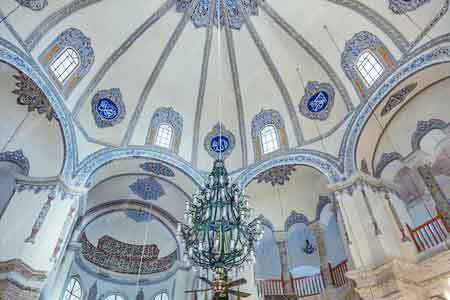
- Originally a church built in the 6th century, it was later converted into a mosque.
- It is notable for its early Byzantine architecture, similar to the Hagia Sophia.
The Walls of Constantinople
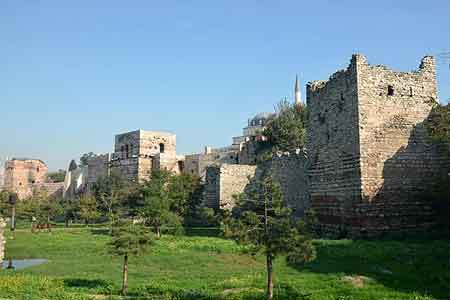
- The historic land walls that once protected Constantinople are remarkably well-preserved in many sections.
- Offers insight into the city’s defence strategies during the Byzantine era.
Image © Wikimedia Commons
Yedikule Fortress (Seven Towers Castle)
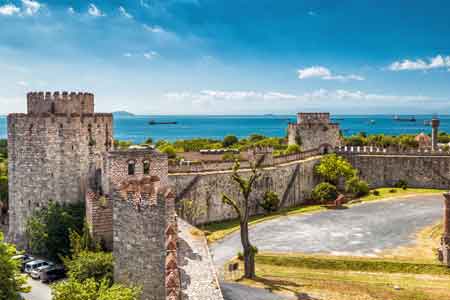
- The historic land walls that once protected Constantinople are remarkably well-preserved in many sections.
- Offers insight into the city’s defence strategies during the Byzantine era.
Spice Bazaar (Egyptian Bazaar)
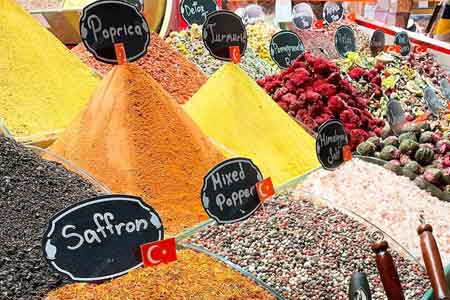
- It is one of Istanbul’s oldest markets, famous for its spices, herbs, and culinary delights.
- A vibrant and colourful shopping experience reflecting Istanbul’s role in the spice trade.
Istanbul's Hisars (Fortresses)
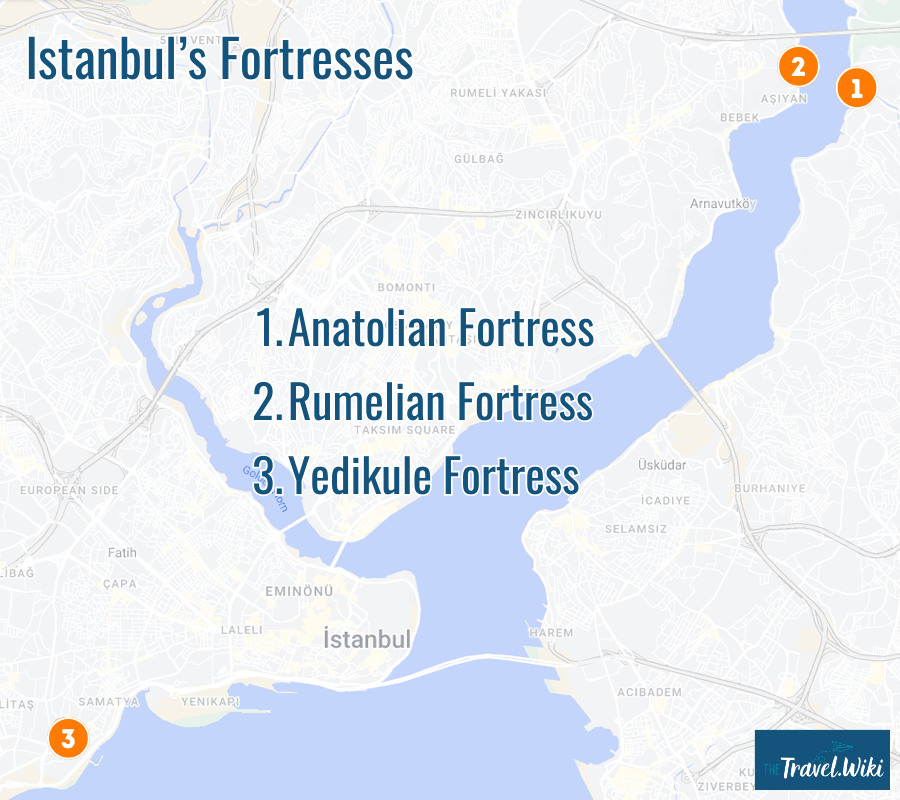
Anadolu Hisarı (Anatolian Fortress)
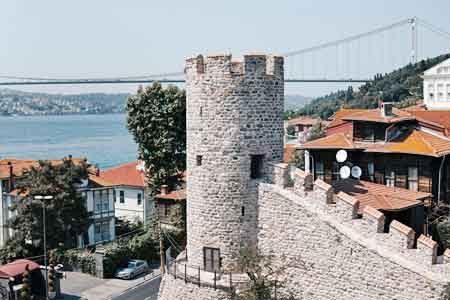
- Built by the Ottoman Sultan Bayezid I in the 14th century, this fortress is located on the Asian side of Istanbul.
- It was constructed to control the traffic along the Bosphorus Strait and played a role in the Ottoman siege of Constantinople.
Rumeli Hisarı (Rumelian Fortress)
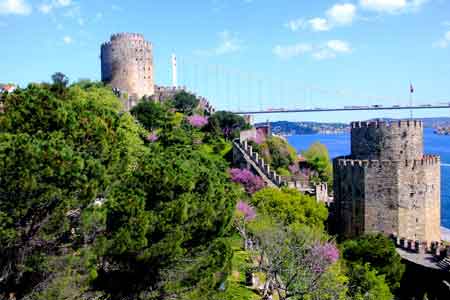
- Constructed directly across the Bosphorus from Anadolu Hisarı, this fortress was built by Mehmed the Conqueror in the mid-15th century.
- It was a critical component in the Ottomans’ successful conquest of Constantinople, serving as a military base and controlling the naval traffic on the Bosphorus.
Yedikule Hisarı (Fortress of the Seven Towers)

- Originally mentioned as Yedikule Fortress, it’s an extension of the Theodosian Walls and was used as a treasury, prison, and execution site throughout history.
- Its imposing structure and towers offer a glimpse into the military architecture of the Byzantine and Ottoman periods.
Areas and Neighbourhoods to Visit to Enjoy Istanbul
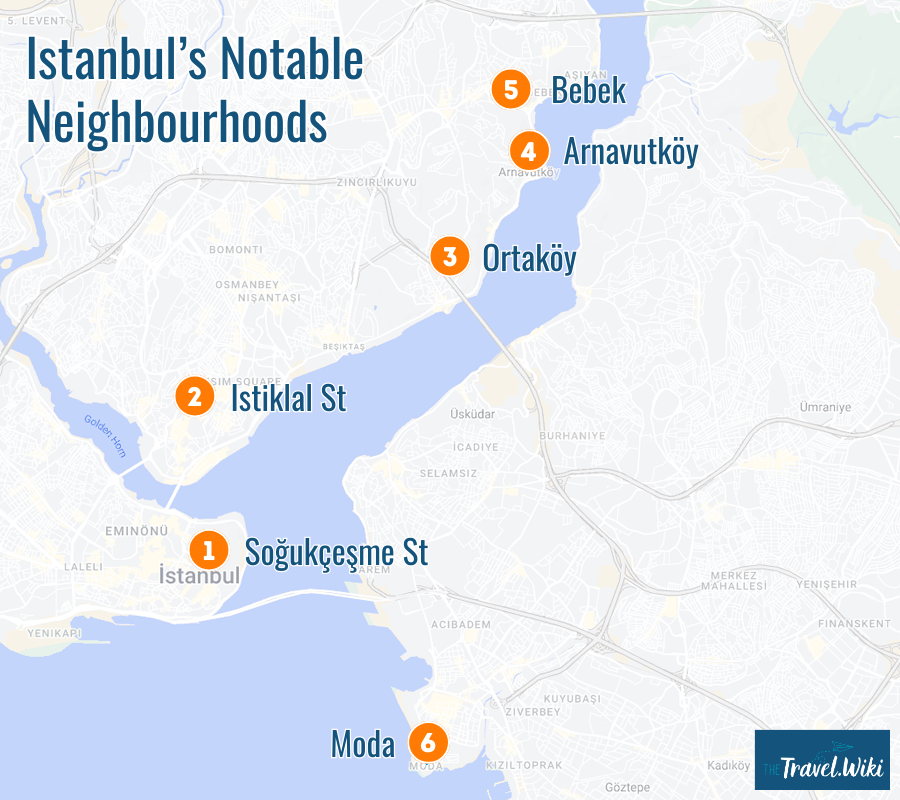
Sogukcesme Sokagi (Cold Fountain Street)
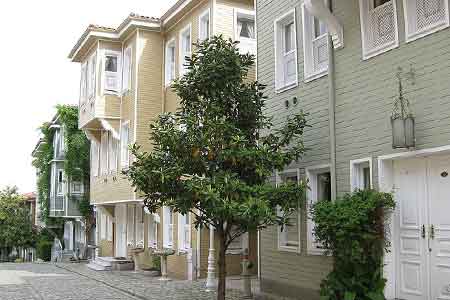
Image © Wikimedia Commons
In the heart of Istanbul’s historical peninsula, nestled between the Hagia Sophia and Topkapi Palace, lies Sogukcesme Sokagi, a charming and picturesque street. This narrow alley is a hidden gem that offers a glimpse into Ottoman-era Istanbul.
Historical Significance
- Sogukcesme Sokagi is lined with historic Ottoman houses, some of which date back to the 19th century.
- The street’s name, translating to “Cold Fountain Street,” originates from a fountain at one end, a vital water source in the past.
Cultural and Architectural Highlights
- The beautifully restored houses, now functioning as boutique hotels and shops, showcase classic Ottoman architecture with wooden facades and ornate window designs.
- The street provides a peaceful escape from the bustling city, offering a sense of what daily life might have been like in the Ottoman era.
Visiting Cold Fountain Street
- It’s a perfect spot for a leisurely stroll, photography, or a quiet break.
- Visitors can enjoy the quaint atmosphere, with some houses open to the public as part of the boutique hotel experience, offering traditional Turkish hospitality.
Sogukcesme Sokagi is a must-visit for those looking to experience the charm of old Istanbul. It’s a delightful contrast to the grandeur of the nearby palaces and mosques, offering a more intimate and personal view of the city’s historical lifestyle.
İstiklal Caddesi (Independence Avenue)
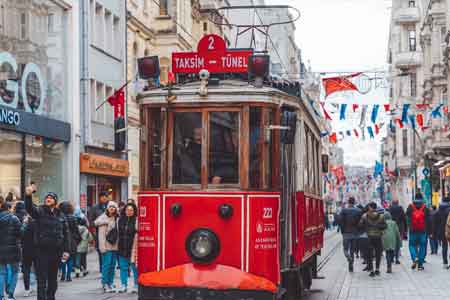
İstiklal Caddesi, one of Istanbul’s most famous streets, runs from Taksim Square to Galata Tower. This bustling avenue is a microcosm of Istanbul’s energy, featuring historic buildings, churches, art galleries, shops, and street performers. It’s also known for its historic tram that runs the length of the street. The area around İstiklal Caddesi, including Galatasaray and Çukurcuma, is renowned for its cultural and nightlife scenes, with numerous bars, clubs, and restaurants.
Bosphorus Villages
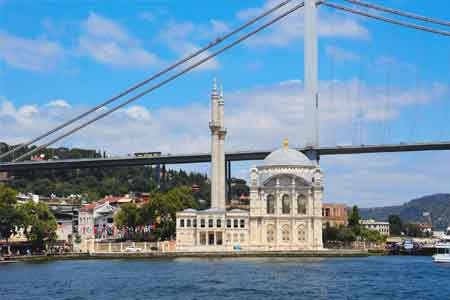
The charming villages along the Bosphorus Strait offer a delightful escape from Istanbul’s bustling city life. These villages, such as Bebek, Arnavutköy, and Ortaköy, are known for their scenic beauty, historic waterfront houses, and vibrant local culture. They provide a glimpse into the city’s maritime heritage and are perfect for enjoying leisurely walks, seafood restaurants, and stunning views of the Bosphorus.
Moda / Kadıköy
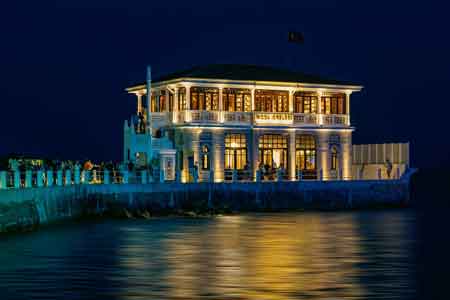
Located on the Asian side of Istanbul, Moda and Kadıköy are vibrant neighbourhoods known for their lively atmosphere. These areas are popular among locals and offer a more authentic experience of Istanbul’s contemporary urban life. The streets are lined with cafes, pubs, bookstores, and shops, reflecting the city’s modern and youthful spirit. The Kadıköy Fish Market and the Moda seaside promenade are particularly popular spots.
Best Istanbul Tours
Guided Tours
Exploring Istanbul’s rich historical tapestry can be greatly enhanced with guided tours. These tours offer deeper insights into the city’s past, anecdotes you might not find in guidebooks, and the convenience of having an expert navigate Istanbul’s complex history and geography.
Historical & Cultural Istanbul Tours
- Focus on key historical sites like Hagia Sophia, Topkapi Palace, and the Blue Mosque.
- Often include stories about the Ottoman Empire, Byzantine history, and cultural evolution.
Istanbul Walking Tours
- Explore Istanbul on foot, focusing on specific neighbourhoods or themes (e.g., food, art, architecture).
- Great for experiencing the local atmosphere and hidden gems.
Istanbul Bosphorus Cruises
- A different perspective of Istanbul from the water, highlighting the city’s maritime history and the beauty of the Bosphorus Strait.
- Options range from short tours to full-day excursions with stops at various points of interest.
Istanbul Food and Culinary Tours
- Experience Istanbul’s rich culinary scene, including traditional Turkish cuisine and street food.
- Visits to local markets, street vendors, and traditional restaurants.
Booking and Planning your Istanbul Visit
- Advance Booking: Recommended, especially during peak tourist seasons.
- Custom Tours: Many companies offer customisable tours to match specific interests.
- Group Size: Consider the size of the tour group for a more personalized experience.
- Language Options: Check for tours offered in your preferred language.
Guided tours not only enrich the understanding of Istanbul’s historical and cultural sites but also provide practical advantages like skip-the-line access and efficient time management whether it’s your first time in the city or a return visit, a guided tour can offer new perspectives and deeper insights into the fascinating city of Istanbul.
Travel Tips and Insider Info
Visiting Istanbul’s historical sites can be a richly rewarding experience, especially with a bit of planning and knowledge about the best times to visit and the most efficient ways to explore them. Here are some travel tips to help you make the most of your journey:
Best Times to Visit to Avoid Crowds
Off-Peak Hours
- Early morning or late afternoon visits are generally less crowded.
- Consider visiting major attractions like Hagia Sophia and Topkapi Palace right when they open or an hour before closing.
- If you need to travel check “Off-Peak Hours and Dealing with Peak Traffic in Istanbul” section below
Seasonal Considerations
- Spring (April to June) and Fall (September to November) are ideal times to visit Istanbul, with milder weather and fewer tourists.
- Summer months (July and August) tend to be the busiest. If visiting during this time, plan to see popular sites early in the morning.
Order of Visiting Sites for Efficient Planning
Geographical Grouping
- Plan your visits based on the geographical proximity of sites.
- For example, Hagia Sophia, the Blue Mosque, and Topkapi Palace are all within walking distance of each other.
Time Allocation
- Allocate more time to larger sites like Topkapi Palace, which can take several hours to explore fully.
- Smaller sites like the Basilica Cistern require less time and can be combined with other nearby attractions.
Cultural and Recreational Balance
- Mix cultural visits with leisure activities. For instance, after a morning of sightseeing, relax in the afternoon with a Bosphorus cruise or a stroll in one of the Bosphorus villages.
Local Events and Holidays
- Be aware of local holidays and events that might affect opening hours.
- Ramadan and other religious observances can lead to altered schedules or closures.
Transportation
- Utilise Istanbul’s efficient public transportation system, including trams and ferries, to move between sites.
- Consider purchasing an Istanbulkart, a rechargeable card for public transport, to save time and money.
Off-Peak Hours and Dealing with Peak Traffic in Istanbul
Visiting Istanbul’s major attractions during off-peak hours is indeed a smart strategy to avoid crowds. However, considering Istanbul’s notorious traffic, especially during rush hours, here are some additional tips for travellers who might not be staying in the vicinity of these attractions:
Plan Your Travel Route
Public Transportation
Utilise Istanbul’s extensive public transportation network, including metros, trams, and ferries, which can often bypass traffic congestion.
Istanbulkart
Invest in an Istanbulkart, a rechargeable card used for public transportation. It’s more cost-effective and convenient than buying single tickets.
Avoiding Peak Traffic Hours
- Rush Hours to Avoid: Typically, rush hours in Istanbul are from 7:00 AM to 9:00 AM and 5:00 PM to 8:00 PM on weekdays. Plan your travel outside these times.
- Stay in Central Locations: If possible, book accommodations in central areas close to major attractions. This reduces reliance on transport during peak times.
Alternative Sightseeing Strategies
- Late Morning Strategy: If you’re not an early riser or staying far from attractions, consider starting your sightseeing a bit later in the morning, after the rush hour, and then extend your visit into the early afternoon.
- Evening Exploration: Many of Istanbul’s historical sites are beautifully lit at night. Exploring these areas in the evening can be a magical experience and a way to avoid daytime crowds.
Use Technology to Your Advantage
- Traffic Apps: Use traffic and navigation apps like Google Maps or Yandex.Navigator to check real-time traffic conditions and find the best routes.
- Public Transport Apps: Apps like Trafi and Moovit can help you navigate Istanbul’s public transport system efficiently.
Consider Guided Tours with Transport
- Some guided tours include transportation from your hotel to the sites. This can be a convenient and time-saving option, especially for distant attractions.
By planning strategically around Istanbul’s traffic and utilising its efficient public transport, visitors can enjoy a more relaxed and efficient sightseeing experience. The aim is to balance the desire to avoid crowds at attractions with the need to navigate through one of the world’s busiest cities.
Remember, each traveler’s interests and pace are different, so feel free to adjust these suggestions to suit your preferences. The key is to balance thorough exploration with moments of relaxation, allowing you to fully absorb the unique atmosphere and rich history of Istanbul.
Cultural Etiquette
Visiting Istanbul offers a unique blend of East and West, and while the city is modern and liberal in many ways, with dress codes similar to Western countries in most areas, it’s important to be mindful of local customs and cultural etiquette, especially at religious and historical sites. Observing these practices not only shows respect but also enhances the travel experience. Here are some key tips for navigating Istanbul’s rich cultural landscape:
Respect at Religious Sites
- Dress Code: Modest clothing is expected in mosques, including covering shoulders and knees for all genders, and women are often required to cover their heads with a scarf, usually provided at the entrance.
- Shoes Off: Remove your shoes before entering a mosque, with storage for footwear typically available.
- Silence and Decorum: Maintain a respectful demeanor, with soft speech and no loud noises inside religious sites.
Photography Rules
- Permission: Check for photography allowances and avoid flash photography where prohibited.
- Respectful Distance: Refrain from photographing worshippers in private moments and avoid using selfie sticks in interiors of historical sites.
General Etiquette at Historical Sites
- Preservation: Avoid touching or leaning on ancient structures and artifacts.
- Littering: Dispose of trash properly to help preserve these sites.
- Queueing: Respect queues, especially at popular sites or exhibits.
Cultural Sensitivity
- Local Customs: Observe or politely inquire about customs if unsure.
- Language: Basic Turkish phrases like ‘Merhaba’ (Hello) and ‘Teşekkür ederim’ (Thank you) can be well-received.
Being aware of these cultural etiquettes ensures a harmonious experience in Istanbul, allowing visitors to immerse themselves in the city’s historical and cultural wonders while respecting its traditions.
My Personal Experience in Istanbul
A City of Diverse Cultures and Histories
Having spent the majority of my adult life in Istanbul, I’ve been privileged to experience the city not just as a visitor, but as a local, immersing myself in its vibrant daily life. Istanbul is a melting pot of cultures, where East meets West, and ancient traditions coexist with modern lifestyles. It’s a place where people from different walks of life, backgrounds, and cultures live side by side, each adding their unique flavor to the city’s already rich tapestry.
The Local Way of Life
- Neighborhood Culture: Each neighborhood in Istanbul has its own character. From the historic streets of Sultanahmet to the trendy cafes of Kadıköy and the upscale boutiques of Nişantaşı, the city offers a diverse range of experiences.
- Tea and Coffee Culture: Locals love their tea (çay) and coffee (Türk kahvesi). Joining friends for a leisurely tea at a local tea garden or a traditional Turkish coffee at a sidewalk café is a daily ritual.
- Bosphorus Lifestyle: Weekends often involve ferry trips across the Bosphorus or leisurely breakfasts at waterfront restaurants in Bebek or Arnavutköy, where the view is as splendid as the food.
- Street Markets and Bazaars: Visiting local markets, such as the Kadıköy Fish Market or the various neighborhood bazaars, is a regular activity for many locals, offering fresh produce and a glimpse into the daily commerce of the city.
Multicultural Harmony
- Religious and Cultural Diversity: Istanbul’s landscape is dotted with mosques, churches, and synagogues, standing as testaments to the city’s historical and ongoing religious diversity.
- Cultural Festivals and Events: The city hosts numerous cultural festivals throughout the year, celebrating everything from film and music to art and food, further highlighting its diverse cultural scene.
Reflections on Living in Istanbul
Living in Istanbul has been an enriching experience, where every day brings a new discovery. It’s a city where history is etched onto every street corner and where the warmth and hospitality of the people make you feel at home. As much as it is a tourist haven, it is, more importantly, a living, breathing metropolis with a soul that captivates everyone who experiences it.
Additional Resources
Official Websites for Historical Sites
- Hagia Sophia, Topkapi Palace, etc.: Visit official sites for the most current visitor information, including opening hours and ticket prices.
Recommended Books
- “Istanbul: Memories and the City” by Orhan Pamuk: A deeply personal account of life in Istanbul by one of Turkey’s most celebrated authors.
- “Istanbul: City of Majesty at the Crossroads of the World” by Thomas F. Madden: Offers a comprehensive history of this enigmatic city.
- “Strolling Through Istanbul” by Hilary Sumner-Boyd and John Freely: A guide to walking tours around the city, uncovering its hidden gems.
Documentaries and Films
- “Istanbul Unveiled”: A documentary that explores the diverse cultures and traditions of Istanbul.
- “Crossing the Bridge: The Sound of Istanbul” by Fatih Akin: A musical journey through Istanbul’s rich and diverse music scene.
Cultural Guides
- Lonely Planet’s “Istanbul” Guide: Provides practical travel advice along with cultural insights.
- “The Rough Guide to Istanbul”: Offers both historical context and contemporary tips for travelers.
Language Learning Resources
- Duolingo or Rosetta Stone: For learning basic Turkish phrases that can enhance your travel experience.
Online Forums and Blogs
- Travel Forums: Websites like TripAdvisor and Lonely Planet forums where you can read about others’ experiences and ask questions.
- Expat and Local Blogs: Personal blogs by expats and locals offer insider tips and stories about life in Istanbul.
These resources will help deepen your understanding of Istanbul’s multifaceted character, enriching your visit or your continued exploration of this captivating city.
